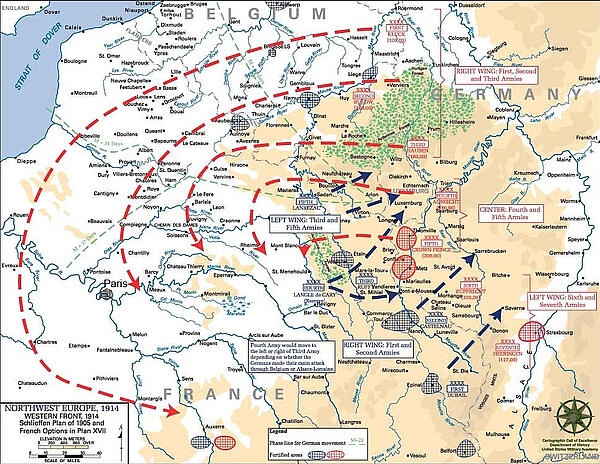The Schlieffen Plan
The Schlieffen Plan was a strategy prepared in the event that Germany faced a two-fronted war with France and Russia. It was masterminded by General Count Alfred von Schlieffen, the chief of the German General Staff between 1891 and 1905. The plan centred around the idea that Germany could defeat France whilst Russia mobilised its forces.
The execution of the Schlieffen Plan led to Britain declaring war on Germany on 4 August 1914. The assassination at Saravejo had triggered divisions within Europe. Italy, Austria and Germany (the Triple Alliance) were split into one camp and France, Britain and Russia (the Triple Entente) into another.
Schlieffen had stated that the western sector would be the critical area in any future war. Due to her proximity, France was identified by Schlieffen as Germany's most dangerous opponent. Russia was seen as only a limited threat due to its limited power and wealth, so Schlieffen worked out that it would take several weeks for the country to mobilise an army. As a result, it was believed that Germany could cope with any minor conflict on the Russian-German border while the majority of her men pushed into France.

Schlieffen concluded that a massive and successful surprise attack against France would be enough to put off Britain becoming involved in the war. This would allow Germany time to mobilise her troops to take on the Russians after a French defeat.
Schlieffen also planned for the attack on France to go through Belgium and Luxemburg. As Belgium’s neutrality was guaranteed by Britain in 1839, he depended on Britain not defending Belgium.
The Schlieffen Plan underwent revisions as European tensions escalated, but the basic principles of the plan stayed the same:
- Germany would launch an attack on France (through Belgium) as soon as Russia announced intentions to mobilise.
- If necessary, she would carry out a holding operation on the Russian/German border.
- Germany was expected to defeat France within six weeks.
- Her improved rail system would allow German troops to move from France to the Russian front.
- Germany would launch an assault on Russia, who would soon be defeated.
However, despite being ambitious, the Schlieffen Plan had a number of obvious weaknesses:
- The timing of Germany’s attack on France was dictated by Russia’s actions.
- It underestimated the amount of time Russia would need to mobilise its troops.
- It was overly ambitious in estimating the timespan for France’s defeat.
- The German army was too small to make the plan work
Schlieffen was succeeded by General Helmuth von Moltke, who moderated the Schlieffen Plan.
In fact, Germany’s attack in August 1914 started well and was only defeated by the first Battle of the Marne. There were several reasons for the failure of the plan. Moltke’s control of the campaign was compromised by poor communication between the front line commanders. Also, Germany’s military clout was weakened when German troops withdrew in response to a higher than expected threat on the Russian front.
In theory, it was a decisive and carefully formulated plan. However, it was too optimistic. Schlieffen's speedy attack and expected defeat of France never occurred.
See also: Count Alfred von Schlieffen
MLA Citation/Reference
"The Schlieffen Plan". HistoryLearning.com. 2024. Web.
